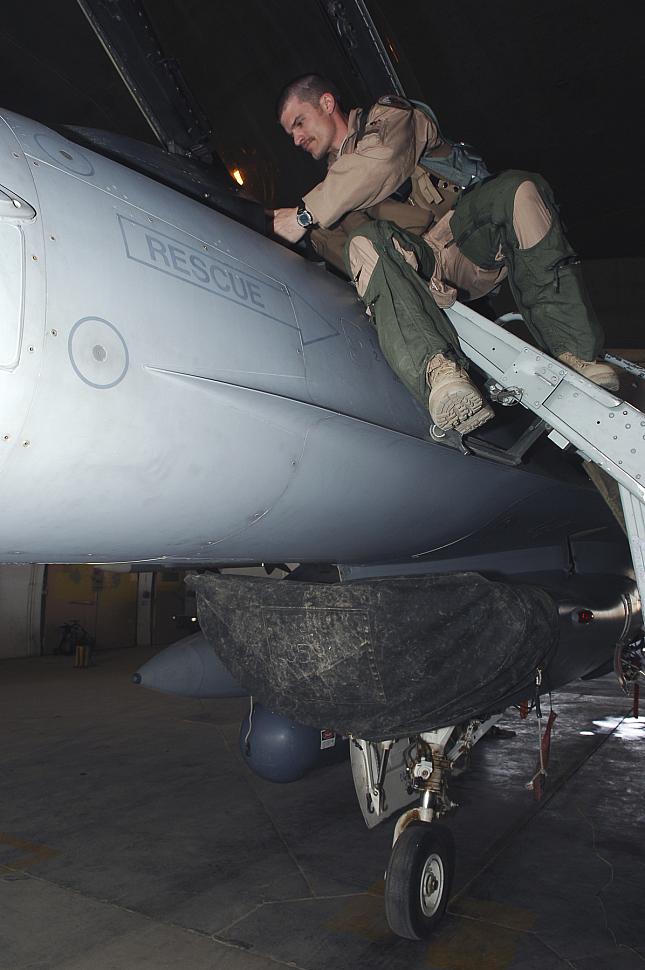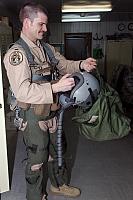Fighter Jet News
F-16 Fighting Falcon News
Bombs on target: Dropping the bomb
April 26, 2008 (by
SSgt. Mareshah Haynes) -
The time has come for the mission to be executed. The pilot advances the F-16 Fighting Falcon to the mission area, soaring across the desert terrain at 500 mph, like the proud and magnificent creature the jet was named after.
Just like a falcon locks its gaze on its prey, the pilot locks his sensors on the target and the bomb is released. It meets the target with precision, destroying only a single building while the surrounding structures remain untouched.
Though it may take only seconds from the time the pilot presses the button until the bomb hits its target, there's a lot intense of planning involved. The process actually begins several hours before.
It all starts with an air tasking order from the Combined Air Operations Center where operations are planned and coordinated, said 1st Lt. Ken Peterson, an F-16 Fighting Falcon pilot assigned to the 332nd Expeditionary Fighter Squadron, deployed from the Montana Air National Guard.
"If there's a preplanned strike, [the CAOC] is going to take a look around the area in question and determine what weapon we want to use and if we use that weapon how we want it to detonate," he said.
Before embarking on their missions, pilots are briefed on topics including weather, intelligence information and what the ground situation is like where the pilot will be. After the briefings, the pilots don all their gear, including a side arm, helmet and survival vest containing a radio and spare batteries, GPS system and water pack weighing nearly 45 pounds, said Maj. Jason Green, an F-16 pilot assigned to the 332nd Expeditionary Fighter Squadron, deployed from the Montana Air National Guard. They wear all of this while controlling the aircraft from the cockpit, where they have about as much room as a person in office chair.
A typical mission for fighter pilots from Balad lasts four to five hours, Lieutenant Peterson said.
Once the pilots reach their mission space, they check in with the joint terminal attack controller, who walks them through what's going on in the area.
Based on how many and what type of weapons the aircraft is carrying, JTACs can figure out how large or small the affected area will be if a munition is deployed, the lieutenant said.
One of the main priorities of the pilots and JTACs is getting the bombs exactly where they want them. Part of the decision making process is understanding where friendly assets are located and attack restrictions.
Oftentimes, if the risk of collateral damage is too high, pilots are directed not to drop their munitions. They may be directed to gather information or just present a show of force.
Targeting is a deliberate, finite process that is very strict and exact in the rules of engagement.
"Just the other day there was a target we could've easily blown up with a bomb, but there would've been far too much collateral damage, so we had to hold off," Lieutenant Peterson said.
Many of the flying missions include providing close air support for convoying servicemembers on the ground seeking out improvised explosive devices and insurgents. The Fighting Falcons have the capability to fly, fight and win in air-to-air and air-to-ground combat and in less than perfect weather conditions.
The over-watch and close air support capability the pilots provide gives ground forces the assurance they need that if they get into trouble, aircraft above them ca provide immediate, measured and lethal delivery of weapons, the lieutenant said.
"The F-16 is a tremendous close air support platform," Lieutenant Peterson said. "We get up there and do anything we can for [the Soldiers on the ground]. I think they can rest a little easier knowing there's an [F-16] up there."
The mission of precision targeting doesn't rest in the hands of just one squadron or group. It's a combined effort between many organizations. Without the munitions specialists, weapons loaders, JTACs and GLOs, the mission would be impossible to complete.
"It [losing the GLO, JTACs, weapons loaders or munitions specialists] would end the mission for us; we're just the part that's on the end," Lieutenant Peterson said. "You take an F-16 with no weapons on it; it doesn't do anybody much good. Or say you take the GLO out; we won't know what's going on. You take any of that away and it becomes extremely ineffective for us, we probably wouldn't even be able to go out there and do it, it would be just a waste of gas."
Because of the dynamic and interactive teams the Air Force has at Balad and through out the area of responsibility, it can continue impact the Global War on Terrorism with the key capability of precision targeting.
The lives of the Iraqi civilians U.S. and coalition forces are trying to protect are valuable and a deliberate decision making process is used to help prevent the unnecessary loss of human life.
"It's tremendous that we can go out and drop a bomb on a house and not blow up the house, but destroy everything in the house," Lieutenant Peterson said. "It allows us to be a lot more effective, especially on the hearts and minds side that we can strike only the bad guys and have minimum impact on the [good] citizens of Iraq."
Though it may take only seconds from the time the pilot presses the button until the bomb hits its target, there's a lot intense of planning involved. The process actually begins several hours before.
It all starts with an air tasking order from the Combined Air Operations Center where operations are planned and coordinated, said 1st Lt. Ken Peterson, an F-16 Fighting Falcon pilot assigned to the 332nd Expeditionary Fighter Squadron, deployed from the Montana Air National Guard.
"If there's a preplanned strike, [the CAOC] is going to take a look around the area in question and determine what weapon we want to use and if we use that weapon how we want it to detonate," he said.
Before embarking on their missions, pilots are briefed on topics including weather, intelligence information and what the ground situation is like where the pilot will be. After the briefings, the pilots don all their gear, including a side arm, helmet and survival vest containing a radio and spare batteries, GPS system and water pack weighing nearly 45 pounds, said Maj. Jason Green, an F-16 pilot assigned to the 332nd Expeditionary Fighter Squadron, deployed from the Montana Air National Guard. They wear all of this while controlling the aircraft from the cockpit, where they have about as much room as a person in office chair.
A typical mission for fighter pilots from Balad lasts four to five hours, Lieutenant Peterson said.
Once the pilots reach their mission space, they check in with the joint terminal attack controller, who walks them through what's going on in the area.
Based on how many and what type of weapons the aircraft is carrying, JTACs can figure out how large or small the affected area will be if a munition is deployed, the lieutenant said.
One of the main priorities of the pilots and JTACs is getting the bombs exactly where they want them. Part of the decision making process is understanding where friendly assets are located and attack restrictions.
Oftentimes, if the risk of collateral damage is too high, pilots are directed not to drop their munitions. They may be directed to gather information or just present a show of force.
Targeting is a deliberate, finite process that is very strict and exact in the rules of engagement.
"Just the other day there was a target we could've easily blown up with a bomb, but there would've been far too much collateral damage, so we had to hold off," Lieutenant Peterson said.
Many of the flying missions include providing close air support for convoying servicemembers on the ground seeking out improvised explosive devices and insurgents. The Fighting Falcons have the capability to fly, fight and win in air-to-air and air-to-ground combat and in less than perfect weather conditions.
The over-watch and close air support capability the pilots provide gives ground forces the assurance they need that if they get into trouble, aircraft above them ca provide immediate, measured and lethal delivery of weapons, the lieutenant said.
"The F-16 is a tremendous close air support platform," Lieutenant Peterson said. "We get up there and do anything we can for [the Soldiers on the ground]. I think they can rest a little easier knowing there's an [F-16] up there."
The mission of precision targeting doesn't rest in the hands of just one squadron or group. It's a combined effort between many organizations. Without the munitions specialists, weapons loaders, JTACs and GLOs, the mission would be impossible to complete.
"It [losing the GLO, JTACs, weapons loaders or munitions specialists] would end the mission for us; we're just the part that's on the end," Lieutenant Peterson said. "You take an F-16 with no weapons on it; it doesn't do anybody much good. Or say you take the GLO out; we won't know what's going on. You take any of that away and it becomes extremely ineffective for us, we probably wouldn't even be able to go out there and do it, it would be just a waste of gas."
Because of the dynamic and interactive teams the Air Force has at Balad and through out the area of responsibility, it can continue impact the Global War on Terrorism with the key capability of precision targeting.
The lives of the Iraqi civilians U.S. and coalition forces are trying to protect are valuable and a deliberate decision making process is used to help prevent the unnecessary loss of human life.
"It's tremendous that we can go out and drop a bomb on a house and not blow up the house, but destroy everything in the house," Lieutenant Peterson said. "It allows us to be a lot more effective, especially on the hearts and minds side that we can strike only the bad guys and have minimum impact on the [good] citizens of Iraq."
Courtesy of 332nd Expeditionary Air Wing Public Affairs
Additional images:
Related articles:
Forum discussion:
Tags
- 1 million sorties flown for GWOT (2008-04-22)
- Bombs on target: loading the bomb (2008-03-21)
- F-16 Fighting Falcon news archive
Forum discussion:
- Start a discussion about this article in the F-16.net forum.
Tags


